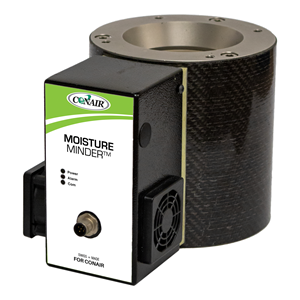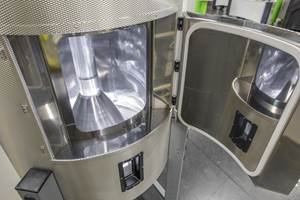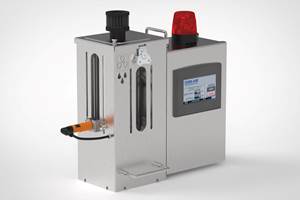Bozzelli’s Dozen Drying Tips
There’s a lot to know about drying—enough to fill a book, at least. But for now, here are a dozen details you need to know, from seasoned injection molding consultant and Scientific Molding trainer John Bozzelli. Scroll down and take his quiz.
1. Automatically monitor filter function with a pressure-differential indicator. If you system does not have one, install one.
2. Keep two sets of filters, one set in use the other being cleaned. Clean with a vacuum, not an air hose. Do not bang the filter to clean it. If you dent it, fines will foul the rest of the dryer.
3. Look into rigging up a thermocouple in the air feed just before the desiccant bed. The air temperature going to the desiccant beds should be below 150 F. If you are running the dryer hotter than 180 F, you’ll need to have an aftercooler on the return line (which should not be insulated) so the air is cooled for the desiccant. The ideal operating temperature for the bed is about 120-150 F (50-65 C).
4. Check your regeneration heater elements regularly. If they are not working properly, you won’t regenerate (dry) the desiccant properly, and it won’t dry your resin as it’s intended to. Put an “idiot light” on the control panel that tells you if the amps drawn by the heater are to specification. Or, you can measure the air inlet temperature to the desiccant bed being regenerated—this should be the temperature required to dry the desiccant. If these two options are not practical for you, measure the air outlet temperature from the bed being regenerated. It must be above 212 F (100 C).
5. Examine the desiccant. Is it still active? Read the supplier’s instructions and you may find a simple test that involves putting dry desiccant into a little bit of water and watching for a temperature rise. Desiccants can become contaminated or ruined by off-gases from processing certain resins. A general rule is to change the desiccant every 18 months.
6. Look for leaks at seals and crushed hoses.
7. Don’t bring the dryer on stream with newly regenerated desiccant before it is cooled down properly. Otherwise you might wind up with a 200-lb pellet clump. With some dryers, you can get a slug of 350 F (180 C) air going into the drying hopper when the system switches desiccant beds.
8. Measure dewpoint. Run at less than -25 F (-32 C) dewpoint—better yet, a good dryer should run at -40 F/C dewpoint. The dewpoint of the drying air does not tell you if the resin is dry, just whether the air is dry enough to do the job.
9. Test some dried resin for moisture content to know if you are drying correctly. Use a moisture-specific method, not simple weight loss. Not all volatiles driven off a resin are water. Use Karl Fischer, dielectric, or other moisture-specific sensors.
10. Do not convey dried material from a central hopper to the machine, or leave it in the machine’s hopper, without a blanket of dry air. Once dry, most resins will pick up moisture in 15 to 30 min.
11. Note where the dry air enters the hopper and meets the resin. Hot air will only travel upward, the path of least resistance. The bottom of the hopper is usually blocked. Therefore, any resin below the dry-air distribution hardware (look for a dip tube) must be drained and put back on top of the hopper load before you start molding.
12. If you dry cellulosics, TPUs, flexible PVC, TPVs, and some other soft-touch resins, check the desiccant’s condition every six months, because these resins emit volatiles that can ruin desiccant.
Related Content
Relaunched Chillers, Blenders, Dryers
NPE2024: New auxiliaries from AEC include chiller that meets new standards for refrigerants.
Read MoreMoisture Monitor Provides Instant Readings to Confirm Drying Efficacy
Real-time monitor measures material moisture continually and set points can be configured so that an alert is issued when the specified moisture level drifts outside prescribed limits.
Read MoreResin Drying Hoppers Offer More Energy Efficiency, Durability and Cleanability
NPE2024: Drying hoppers provide improved energy efficiency and a durable textured metal exterior finish. Thicker insulation provides a cooler working environment, while polished stainless steel interiors resist material entrapment, and make cleanouts and changeovers faster.
Read MoreRead Next
Troubleshooting Screw and Barrel Wear in Extrusion
Extruder screws and barrels will wear over time. If you are seeing a reduction in specific rate and higher discharge temperatures, wear is the likely culprit.
Read MoreAdvanced Recycling: Beyond Pyrolysis
Consumer-product brand owners increasingly see advanced chemical recycling as a necessary complement to mechanical recycling if they are to meet ambitious goals for a circular economy in the next decade. Dozens of technology providers are developing new technologies to overcome the limitations of existing pyrolysis methods and to commercialize various alternative approaches to chemical recycling of plastics.
Read More.jpg;width=70;height=70;mode=crop)










